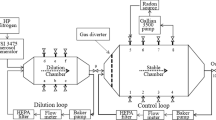Abstract
With the construction and development of nuclear facilities, many nuclear production sites need to monitor artificial radioactive aerosol. However, radon and its daughters are ubiquitous in the environment, and their concentration levels are considerably higher than those of artificial radioactive aerosols. Therefore, artificial radioactive aerosol monitors can reliably measure environmental artificial radioactive aerosol only by testing the effectiveness of radon daughter compensation. By studying the mechanism of radon progeny aerosol and establishing a radon progeny aerosol control device that meets the measurement standards, the concentration of radon progeny aerosol in a radioactive aerosol monitor in certain places can be corrected. Thus, the interference to the measurement of specific radioactive aerosol can be reduced in the high radon environment of such places. In this study, we established a radon progeny aerosol control device that can be used to compensate the radon daughter aerosol for the radioactive aerosol monitoring equipment and help to eliminate or reduce the radon progeny aerosol interference of the radon daughter aerosol correction radioactive aerosol monitoring equipment.










Similar content being viewed by others
References
Li H, Jia M, Li G, Wang Y (2012) A continuous plutonium aerosol monitor for use in high radon environments. Radiat Prot Dosimetry 148(2):258–262
Cai XM, Shan J, Le YL, Luo Y, Li YD (2021) Rapid determination of radon progeny concentration based on artificial neural networks. J Radioanal Nucl Chem 330:747–753
Zhou C, Zhang Q, Jiang Y, Wang L, Sun L (2011) Evaluation of radioactive aerosols in nuclear accident monitoring. Nuclear Techniques 34(11):866–871
Engelbrecht R (2020) Environmental radioactivity monitoring. In: Handbook of radioactivity analysis: Volume 2. Academic Press, London, pp 1–40
Hoarau G, Dougniaux G, Gensdarmes F, Cassette P, Ranchoux G (2022) Impact of the coarse indoor non-radioactive aerosols on the background radon progenies’ compensation of a continuous air monitor. Health Phys 122(5):563–574
Grivaud L, Fauvel S, Chemtob M (1998) Measurement of performances of aerosol type radioactive contamination monitors. Radiat Prot Dosimetry 79(1–4):495–497
Zeng C, Zhou J, Lai W, Feng X, Chen J, Yu Y (2021) Review of radon and its progeny measurement technology in environmental gamma measurement. J Phys: Conf Ser 1739(1):012024. IOP Publishing
Lehto J, Fournier C, Omtvedt JP (2017) Basics of nuclear physics and of radiation detection and measurement. University of Oslo, Oslo
Honig A, Paul A, Röttger S, Keyser U (1998) Environmental control of the German radon reference chamber. Nucl Instrum Methods Phys Res Sect A 416(2–3):525–530
Horan AJ, Krasnomowitz JM, Johnston MV (2017) Particle size and chemical composition effects on elemental analysis with the nano aerosol mass spectrometer. Aerosol Sci Technol 51(10):1135–1143. https://doi.org/10.1080/02786826.2017.1335390
Chen B, Zhang L, Zhuo W (2011) Screen method of nanoscale aerosol particle size distribution measurement study. J Environ Occup Med 28(5):286–288. https://doi.org/10.13213/j.carol.carroll.nki.jeom.2011.05.002
Porstendorfer J, Wicke A, Schraub A (1978) The influence of exhalation, ventilation and deposition processes upon the concentration of radon (222Rn), thoron (220Rn) and their decay products in room air. Health Phys 34(5):465–473
Zhang Zhi-hui (1994) Measurement method of Radon and its progeny in air, vol 03. ISBN: 7502210393. Atomic Energy Press, pp 13–18
Author information
Authors and Affiliations
Corresponding author
Additional information
Publisher's Note
Springer Nature remains neutral with regard to jurisdictional claims in published maps and institutional affiliations.
Rights and permissions
Springer Nature or its licensor (e.g. a society or other partner) holds exclusive rights to this article under a publishing agreement with the author(s) or other rightsholder(s); author self-archiving of the accepted manuscript version of this article is solely governed by the terms of such publishing agreement and applicable law.
About this article
Cite this article
Xiangming, C., Jian, S., Zhangming, C. et al. Radon progeny aerosol control device and related metrological research. J Radioanal Nucl Chem 333, 615–627 (2024). https://doi.org/10.1007/s10967-023-09297-2
Received:
Accepted:
Published:
Issue Date:
DOI: https://doi.org/10.1007/s10967-023-09297-2




